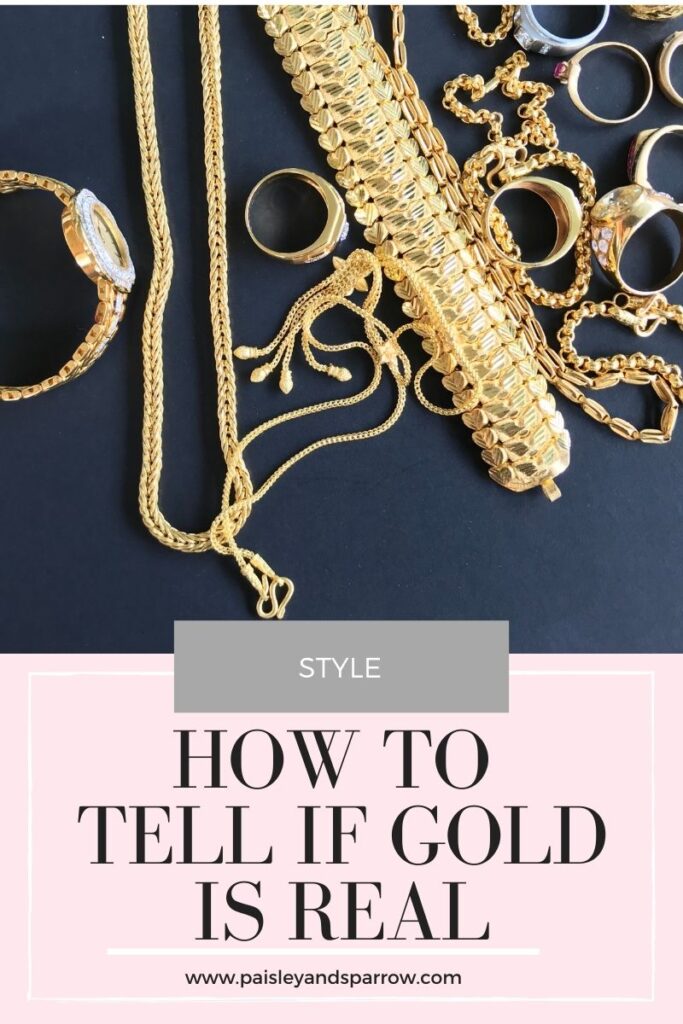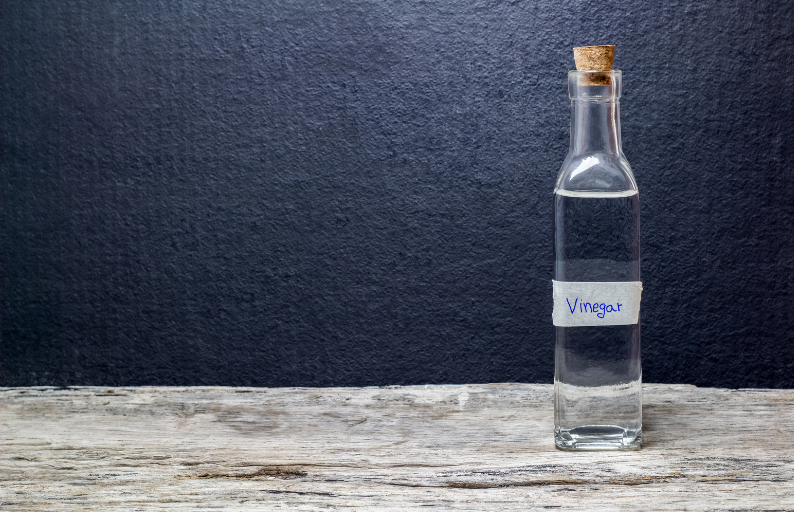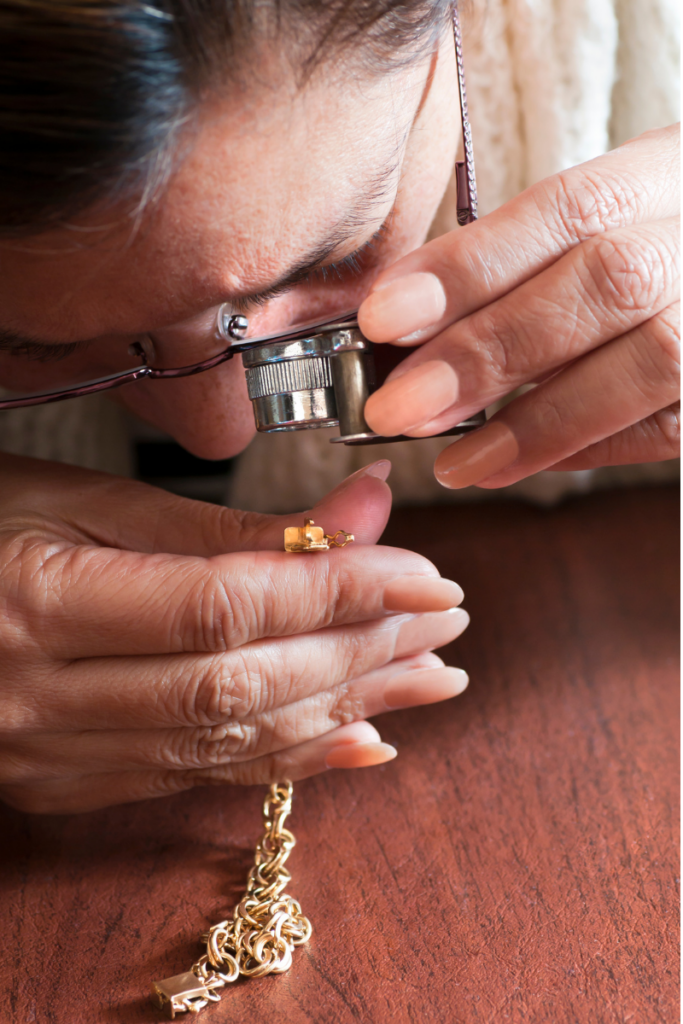Gold. For thousands of years, this precious metal has been considered one of the most valuable and beautiful materials in the world. To this day, it’s a sign of wealth and luxury that everyone wants to get their hands on.
But with this prestige comes a lot of imitation gold pieces that can be tricky to spot. In this guide, we’ll be sharing a little bit of background on gold as well as tips on how to tell if your gold jewelry is real.
History of Gold
As you can probably imagine, gold has been one of the most precious commodities in the world for thousands of years. Societies all over the world have used it for everything from currency and architecture to jewelry and décor. Some ancient civilizations even believed it to have healing powers!

Perhaps no society is as well-known for its use of gold as the ancient Egyptians. As early as 3000 B.C., Egyptians had access to a plentiful supply of gold and used it to create jewelry and other adornments for royalty, along with gold bars that were used for trading.
These precious metals was also considered incredibly rare and has been the spark that ignited many battles over the past few millennia.
To this day, gold is still used as a major asset for the world’s banks. The money used in America today is still backed by gold, making it one of (if not the) most valuable commodities in the world today.
Gold Properties
Given gold’s rich history, you’re probably thinking there must be a reason why it’s considered so precious and coveted, right? You’d be correct!
Of course, gold first and foremost has been prized for its beauty. Its rich warm yellow tone and natural shine are probably the first things that caught the eye of those who discovered this element so long ago. But beauty isn’t the only reason why gold is so special.
One thing that makes pure gold so useful is its malleability. Gold is easy to work with and can be pounded and drawn out an incredible amount.
This flexibility in particular has made it a favorite for jewelry makers, metalsmiths, and other craftsmen. Gold plating and leafing are good examples of just how ductile this metal can be.
One fun fact is that gold leaf can be hammered to a thinness of seven-millionths of an inch – this means that a stack of 7,055 sheets would be no thicker than a dime!
On the more technical side of things, gold is also an excellent conductor of both heat and electricity. Gold outlasts both copper and silver in terms of conductivity because it is resistant to tarnish.
It’s also so reflective of heat and light that astronauts’ space helmets feature an incredibly thin layer of gold to reduce glare – notice the gold color of the visor next time you see a picture of one! We bet you didn’t know that!
How to Test Gold at Home
Even since gold was discovered, it’s been a well-established symbol of wealth, status, beauty, and power. Unfortunately, like many fashionable status symbols, this means that gold is a prime target for forgery. From painted plastic to lower-quality metals, there is plenty of fake gold jewelry out there.
With these ten steps, you’ll be able to test your gold jewelry items for yourself and confirm whether your gold is real or imitation.
1. Stamp Test
One of the quickest ways to see if your gold is authentic is to look for an engraved hallmark somewhere on the jewelry. This stamp identifies your metal’s content and/or manufacturer. It may take a little bit of detective work to find on a larger piece, but grab yourself a magnifying glass and look on the back and sides of your jewelry.
The hallmark will be numbers that fall under either the Karat system or the Millesimal Fineness system. You can find lists of all the purity numbers you may find and if the numbers are anything other than these values, they’re likely fake.
While this method of testing is not 100% foolproof, as the manufacturer can always make fake markings for their fake jewelry, this is a good starting point.
2. Letting Markings
If you recognize the markings GP, GF, GE, GEP, HGP, or HEG on your jewelry piece, the item is considered fake. Even gold-plated or gold-filled items are considered a fake item because they contain a small percentage of real gold.
For reference, 24 karat gold is 99.9% pure and 18 karat gold is 75% gold. You’ll never find 100% gold since gold is so soft and easily warped.
3. Float Test
One easy test is the float test, also called the density test! Gold is an incredibly dense metal. In fact, one square foot of solid gold can weigh over half a ton! For this reason, real gold jewelry will rarely float.
Place your gold item in a cup of water and notice if it floats or sinks.
4. Scratch Test
One of the most foolproof methods for testing your gold jewelry is the ceramic scratch test. For this method, get an unglazed ceramic plate or piece of tiles and scrape a piece of gold across the surface.
Real gold will leave a gold-colored marking, which other metals will just leave a black streak. Be careful to only scrape the tile enough to reveal a gold marking to avoid damaging your jewelry.
5. Skin Test (discoloration)
You’ve probably owned a piece of jewelry that, when worn for an extended period of time, leaves a blue, green, or purple tint on your skin. This is a sign of oxidation and a tell-tale sign of cheap and fake metal. However, real gold won’t leave any discoloration on your skin.
A good way to test this is to hold your piece of gold jewelry in your bare hands for a few minutes. If the piece is real, you shouldn’t notice any color on your skin. It’s worth noting that if your gold comes in contact with liquid foundation, it may turn your skin black at those points of contact. Make sure to wash your hands before testing just to make sure.
6. Magnet Test
If you have a strong magnet handy, hold it up to your gold jewelry. Gold is not magnetic, so if you see any attraction, then the piece is not real gold. However, there are other metals that aren’t magnetic either, so this test isn’t foolproof on its own.
7. Vinegar Test

For this simple test, all you’ll need are a few drops of vinegar. Find an inconspicuous location on your gold jewelry item and apply a bit of vinegar to the metal. Real gold won’t change color but if the metal is fake gold, there may be a change.
8. Nitric Acid Test
Gold is considered a noble metal, which means it is resistant to oxidation and corrosion from acids. This is why it shouldn’t change color when it comes into contact with your skin, vinegar, or nitric acid.
To perform the nitric acid test, rub your gold item on a black stone to leave a visible mark, then apply the nitric acid to the mark. Nitric acid will dissolve any base metals that aren’t gold, a real gold mark will remain.
Next, you can apply aqua regia to the mark to further confirm your gold’s authenticity. This solution will dissolve real gold.
Fail-Safe Tests
9. Gold Testing Machines
Thankfully, with today’s technology, determining whether your gold piece is real or not has become easier than ever. One example of this is a gold testing machine. These machines allow you to quickly identify whether your piece is genuine gold without potentially damaging your piece.
The two main types of machines for testing gold jewelry are an electronic tester and an XRF spectrometer. These machines send either X-rays or electromagnetic waves through your gold piece and record and analyze how these different waves interact with the metal.
Using this information, the machine will tell you whether your piece is the real thing in a matter of seconds. The XRF spectrometer in particular is considered the fastest and most accurate of the tests.
10. Bring it to a Reputable Jeweler
While these home testing methods can be quick and easy ways to get an answer on whether your gold is real or not, there is still room for error. Some fake metals can pass these tests and look exactly like authentic gold. So, the best way and most reliable way of authenticating your gold is to take it to an experienced jeweler.

Reputable jewelers or jewelry stores will often have access to a wide array of testing methods that the average person does not. This combined with their many years of experience with creating and/or analyzing gold jewelry means that they can spot what’s fake with ease.
The most experienced jewelers have likely handled many fake gold items and may even be able to tell you whether your piece is the real deal or not with just a look.
With plenty of fake gold pieces circulating the market, you can’t always take your gold jewelry pieces at face value. By performing these at-home tests, you may just be able to confirm whether your item is real or not before you take it to a jeweler.
Now that we know how to test for fake jewelry, let’s move on to designer bags! Here’s some tips for spotting a fake Gucci bag and also how to know if your Louis Vuitton is fake!
